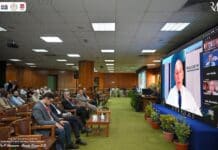
Spanish
Dutch
French
German
Norwegian Bokmål
Polish
Swedish
Builders have discovered significant archaeological remains during the conservation, restoration, and rehabilitation works at Rubalcava Palace. The find was made in the northern garden of the building, next to Plaza de Santiago, where excavation work ahead of installing a fire protection system revealed an underground structure.
This structure has been identified as part of an Andalusian thermal complex, specifically a hot room of Arab baths dating back to around the 11th century AD.
Matías Ruiz, the Councillor for Urban Planning and Historical Heritage, emphasized the importance of the discovery, stating: “This is an extremely relevant find, both due to its age and the excellent state of preservation. These 11th-century Arab baths place us in an early medieval context, which enriches our understanding of Orihuela’s history and heritage.”

DISCOVERY DETAILS
As part of the Rubalcava Palace restoration work, which aligns with the Special Protection Plan for the Historic Centre, an area measuring 8 meters in length, 3.5 meters in width, and 2.5 meters in depth was excavated to house a fire protection system.
It was during this work that historical construction elements were discovered, prompting the suspension of the project and the activation of the archaeological protection protocol.
Specialized technicians and archaeological documentation have confirmed that the remains belong to an early medieval Arab bath complex.
The construction features identified include a rectangular room measuring 9 meters in length by 4.64 meters in width, where a hypocaust (underground heating system) measuring 5.5 x 3 meters, an adjoining alcove of 3 x 2 meters, and several access points leading to other unearthed rooms have been preserved.
The heating system, typical of Andalusian baths, used a furnace to generate hot air, which was distributed under the floor via brick pillars. Some elements show signs of heat damage, confirming the original use of the structure.
Councillor Ruiz explained that, following initial assessments and in coordination with the Territorial Service of Culture and Sport of the Generalitat Valenciana, the project’s management and municipal technicians have agreed on a comprehensive protection plan for the discovered remains.
These will be preserved in their current location and incorporated into the future museum project as part of the historical tour of Rubalcava Palace. The originally planned fire protection system will be relocated to avoid interfering with the site, in line with the recommendations made by territorial archaeologist José Luis Simón García during his technical visit on March 25.
Additionally, the councillor revealed that the City Council is already working on a proposal for the museum project, which will involve the conservation, signage, and lighting of the remains, ensuring their integration into the garden design and facilitating public viewing.
“Our aim is twofold: to complete the rehabilitation of Rubalcava Palace, and to highlight this discovery so that residents and visitors can experience such a unique element up close. The plan is for the structure to be visible from the outside through lower lighting that will highlight it, allowing us to connect with and appreciate the heritage without damaging the structure,” stated Ruiz.
The councillor also explained that once the current phase of work is complete, the City Council will undertake a more extensive archaeological intervention to fully excavate the complex, assess the full extent of the thermal facility, and develop a specific museum and dissemination project, which will be included in future budget allocations.
This discovery adds a new historical attraction to Rubalcava Palace, transforming it into a reference point for Orihuela’s Andalusian past.
Spanish
Dutch
French
German
Norwegian Bokmål
Polish
Swedish




















